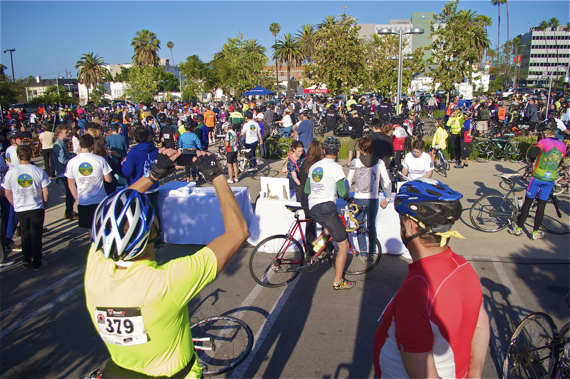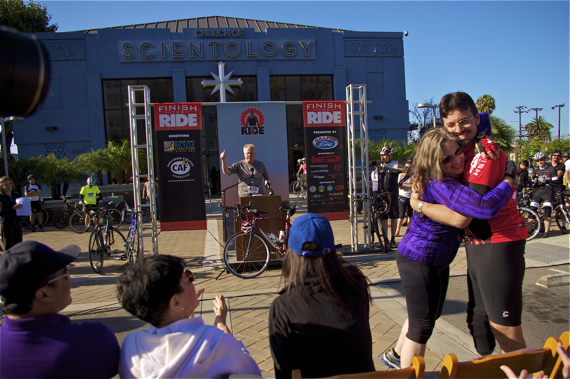
So, this is what it takes to make people angry enough to care, I thought as I looked out over the sea of elected officials, journalists, cameras, and cyclists gathering at the start point for Damian Kevitt's Finish the Ride event Sunday morning.
It apparently takes someone like Kevitt being dragged under a van onto the freeway, suffering 20 broken bones, losing a leg, and surviving for the city to finally recoil in horror at what is being called the "hit-and-run epidemic plaguing Los Angeles."
Somehow, until now, the approximately 20,000 hit-and-runs recorded in the city each year -- only 20% of which are ever solved -- had not been enough to get people riled up.
Neither had the fact that the actual number of hit-and-runs is probably much, much higher.
Bike commuters, wheelchair users, and youth in lower-income areas often tell me they've been hit multiple times but have never reported the incidents. Even the incident that killed Andy Garcia last September in Boyle Heights was not the first encounter he had had with a hit-and-run driver. The first had happened several months earlier and left him unconscious and bleeding from the head by the side of the road. It was not reported.

And, sympathy has not always been with the victims.
In reports about such incidents, events have often been described in a way that blamed cyclists or pedestrians for being in the street or behaving badly before all the details of the case were fully established. Meanwhile, trying to get accurate and meaningful data on hit-and-runs from the LAPD so that the problem can be better understood remains somewhat of an exercise in futility (see here and here).
Even those reporting a hit-and-run at 120th and S. Figueroa just this past weekend still seemed to be struggling to strike the right tone when they began by announcing that the slain man, 47-year-old Von Dedric Miles, "has an arrest record, but...is clearly the victim in this case."
That approach is likely due to the attitude of many, including some of those in law enforcement, that pedestrians and cyclists are a nuisance to drivers.
Take the Central Division's fancy new PSA in which the LAPD's Capt. John McMahon declares the importance of letting people know that downtown is an urban environment that can be dangerous to them. And, that crossing in marked crosswalks while the walk signal is counting down (read: dawdling in car zones) would only cause gridlock, honking, and headaches, deteriorating the overall quality of life for everyone else.
Those working to raise awareness about hit-and-runs haven't always had it easy, either.
Take the case of the United Riders of South L.A., who hold a monthly ride in Gardena in honor of hit-and-run victim Benjamin Torres. On a ride last July to the site where Torres was killed, the cyclists -- some of whom included Torres' family members -- were racially profiled, pulled over by a handful of squad cars, and ticketed by officers who clearly did not understand the laws they are sworn to enforce.
In other cases, the race and/or economic status of the victim has dictated whether or not the case has made the news.
When USC students Adrianna Bachan and Marcus Garfinkle were brutally run down and left for dead in March of 2009 -- with the driver stopping only so the male passenger could peel Garfinkle off the windshield -- the city was rightfully outraged.
The images of a beautiful young girl lost and her tearful mother crying out for justice prompted the city, the County Board of Supervisors, the university, and an anonymous donor to offer rewards for information leading to an arrest totaling $235,000. Under pressure from the intense media interest and the number of tips the huge reward generated, "all four detectives in the South Bureau Traffic Division [of the LAPD], along with several police officers and about 12 of the bureau's best homicide detectives, who put their other cases on hold," were assigned to the case.
The case of Agapito Gaspar Nicolas, a 55-year old Guatemalan native who was struck and killed that same night on N. Figueroa in Highland Park as he went to buy burritos for his girlfriend's children, got no such fanfare.
Instead, the case was handed over to one over-worked detective, saw almost no media attention, and was still waiting for the mayor to approve a $50,000 reward for information on the case more than a month after the incident (See full LAT piece comparing the cases here).

While some of these dynamics are thankfully beginning to change, for street safety to improve for all, we need legislation that sends a strong signal that the city and state take the protection of human life seriously.
Which is why it was heartening to see such a strong show of support from elected officials for the movement Finish the Ride hopes to spark to make the streets of L.A. safe and fun for all.
Speaking before the ride, Congressman Adam Schiff (D-CA) described his own hairy experiences riding to work in Washington D.C.
They had helped him see that development had to evolve beyond just building more freeways, he said, declaring, "The road belongs to all of us!"
"I remember when a DUI was considered 'meh'...," said Assemblyman Mike Gatto (D-Los Angeles) of the role of laws in changing culture.
The belief that, legislatively, it was "time to declare that enough is enough!" had been behind his efforts to extend the statute of limitations on hit-and-runs and put in place a mandatory 6-month license suspension for those caught leaving the scene.
Picking up the legislative thread, Councilmember Mitch O'Farrell lamented the challenge of "legislat[ing] consciousness," and asked Kevitt to "Let us be angry on your behalf...at the indifference in society for people who witness crimes against others and look the other way."
Not to be outdone, Councilmember Tom LaBonge declared that, despite being dismayed that "we haven't found the devil" that hit Kevitt, he was committed to the cause of safer streets.
In a fit of enthusiasm, he pulled one of Kevitt's nurses up to the podium to thank her for her work and, to her great surprise, gave her the microphone.
The clearly startled woman first stammered that she wasn't sure what to say. Then, taking a breath, she underscored the reason everyone was there and why addressing hit-and-runs was so important.
"[It's] insane," she said, speaking of auto-human collisions, particularly those involving pedestrians -- the majority of the cases she sees.
"What I see and what I treat on a daily basis..." she shook her head. "...Insane."

The Finish the Ride event Sunday was a collaboration between Finish the Ride and the Los Angeles County Bicycle Coalition (LACBC), with proceeds going to both the LACBC and the Challenged Athletes Foundation. If you'd like to learn more about Finish the Ride, please click here.






